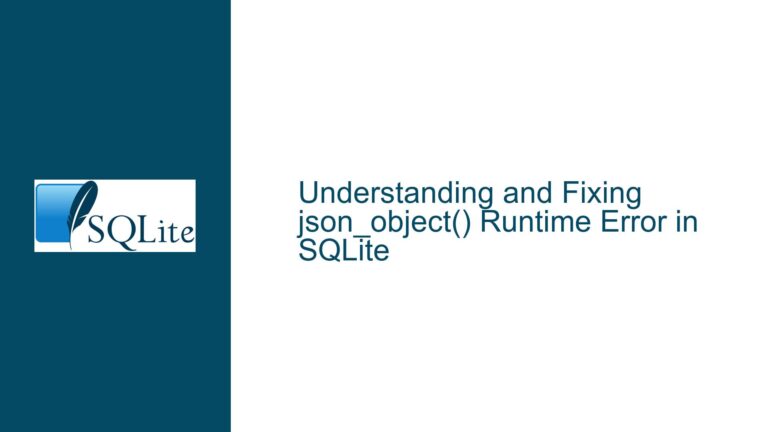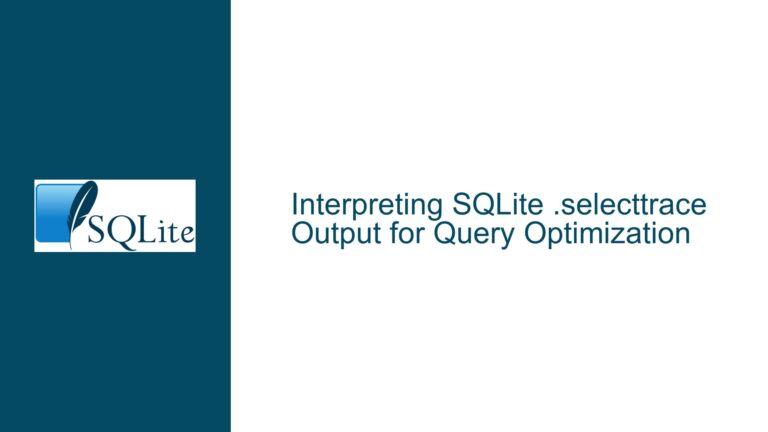RowID Reassignment Determinism in SQLite VACUUM Operations
RowID Stability and VACUUM Behavior in SQLite
Core Mechanics of RowID Assignment and VACUUM Impact
In SQLite, the rowid is a 64-bit signed integer that uniquely identifies a row within a table. For tables lacking an explicit INTEGER PRIMARY KEY column, SQLite automatically generates this rowid. When an explicit INTEGER PRIMARY KEY is declared, it aliases the rowid, ensuring stability across most operations. However, the absence of such a declared column means the rowid becomes a volatile value that can change under specific maintenance operations like VACUUM.
The VACUUM command rebuilds the entire database file, reclaiming unused space and defragmenting data storage. During this process, tables are recreated from scratch: data is copied into a temporary structure, the original tables are dropped, and the temporary data is rewritten into new tables. For tables without an explicit INTEGER PRIMARY KEY, this recreation phase involves reinserting rows in an order determined by SQLite’s internal algorithms. Since rowids are dynamically assigned during insertion (based on the largest existing rowid in the table at the time of insertion), the absence of a guaranteed insertion order during VACUUM introduces uncertainty in rowid reassignment.
The critical question is whether the reassignment of rowids during VACUUM follows a deterministic pattern when the database content is identical before vacuuming. Determinism here implies that two successive VACUUM operations on the same database state would produce identical rowid mappings. SQLite’s documentation explicitly avoids guaranteeing this behavior, and the internal mechanisms that influence rowid assignment during VACUUM are not designed to enforce such determinism.
Factors Contributing to Non-Deterministic RowID Reassignment
The non-deterministic nature of rowid changes during VACUUM arises from multiple factors tied to SQLite’s storage engine and optimization strategies.
Page Allocation and B-Tree Rebalancing: SQLite stores table data as B-Tree structures. During VACUUM, these B-Trees are rebuilt. The order in which rows are copied into the new B-Tree can vary depending on fragmentation patterns, prior deletion markers, or page utilization metrics. For example, if a table has undergone numerous deletions, the vacuum process might consolidate remaining rows into fewer pages, altering the insertion sequence and thus the rowid assignments.
Index-Driven Insertion Order: If a table has associated indexes, the vacuum process may use these indexes to optimize the data copy phase. The choice of index (e.g., a covering index) can influence the physical order of rows in the rebuilt table. Since rowid assignment depends on insertion order, this indirect dependency on index selection introduces variability.
Parallel Thread Execution and Caching: While SQLite serializes write operations, internal caching mechanisms (e.g., the page cache) can affect how data is staged during the vacuum operation. Subtle differences in cache state or memory allocation might lead to divergent insertion orders, even for identical database content.
SQLite Version-Specific Optimizations: The SQLite development team continuously improves the database engine. Algorithms governing vacuum operations may change between versions, leading to different rowid assignment behaviors for the same dataset. For instance, a newer SQLite version might implement a more efficient page-splitting strategy during B-Tree construction, altering row insertion order.
File System and Hardware Interactions: Though less common, low-level factors such as file system block allocation policies or storage hardware characteristics might influence how SQLite writes data during VACUUM. These external factors are outside SQLite’s control and can contribute to non-determinism.
Strategies for Ensuring RowID Stability and Mitigating Risks
To avoid reliance on rowid stability, developers should adopt schema designs and maintenance practices that eliminate dependencies on rowid values post-VACUUM. Below are detailed strategies:
1. Explicit INTEGER PRIMARY KEY Declaration
The most robust solution is to define an INTEGER PRIMARY KEY column for every table. This column aliases the rowid and guarantees stability across VACUUM operations. For example:
CREATE TABLE inventory (
item_id INTEGER PRIMARY KEY,
name TEXT NOT NULL,
quantity INTEGER
);
In this schema, item_id becomes an alias for the rowid. Even after VACUUM, the values in item_id remain unchanged.
2. Synthetic Identifier Columns
For tables requiring a non-integer primary key, introduce a separate column explicitly designated as the rowid alias:
CREATE TABLE customers (
customer_uuid BLOB PRIMARY KEY,
rowid_alias INTEGER,
name TEXT,
FOREIGN KEY(rowid_alias) REFERENCES other_table(id)
) WITHOUT ROWID;
However, the WITHOUT ROWID clause complicates this approach. Instead, using an INTEGER column solely for stable row identification is preferable.
3. Data Integrity Checks Post-VACUUM
If modifying the schema is impractical, implement post-VACUUM validation routines. These routines can compare pre- and post-vacuum rowid mappings using checksums or export/import comparisons:
- Export the database to a text file (e.g., using
.dump) before VACUUM. - Perform VACUUM.
- Re-export the database and compare rowid sequences.
While this does not prevent rowid changes, it helps identify tables affected by reassignment.
4. Avoiding RowID Dependency in Application Logic
Review application code for hidden dependencies on rowid values. Common pitfalls include:
- Storing rowids in external systems (e.g., caching layers) without revalidation.
- Using rowids as foreign keys in related tables without an explicit INTEGER PRIMARY KEY.
Refactor such logic to use stable identifiers.
5. Custom Vacuum Strategies
For advanced use cases, consider alternative approaches to reclaiming space without using VACUUM:
- Incremental Vacuum: When using
PRAGMA auto_vacuum = INCREMENTAL, space is reclaimed incrementally without full database rebuilds. - Manual Data Reorganization: Write custom scripts to copy data into new tables with explicit rowid preservation.
6. Version-Controlled Schema Migrations
When rowid stability is critical for backward compatibility, employ schema migration tools that track and adjust for rowid changes. For example, during a migration:
- Create a new table with an explicit INTEGER PRIMARY KEY.
- Copy data from the old table, preserving rowid values in the new primary key column.
- Drop the old table and rename the new table.
This ensures that future VACUUM operations do not alter the primary key values.
7. Leveraging SQLite’s Backup API
Use SQLite’s Online Backup API to create a backup of the database before executing VACUUM. This allows restoration of pre-vacuum rowid mappings if post-vacuum validation fails.
8. Monitoring SQLite Internals
Advanced users can monitor SQLite’s internal behaviors using debugging tools or custom builds. For example:
- Enable SQLite’s debugging mode to log page allocation and row insertion orders during VACUUM.
- Analyze the generated logs to identify patterns in rowid assignment.
While this does not guarantee determinism, it provides insights into how rowids are reassigned under specific conditions.
9. Community and Vendor Consultation
Engage with the SQLite community or database consultants to explore edge cases specific to your application. The SQLite mailing list and forums are valuable resources for discussing vacuum-related behaviors.
By combining these strategies, developers can mitigate risks associated with rowid reassignment and ensure robust, maintainable database schemas.






